Photo: Paul Rudderow
Philadelphia Union are now 3-4-2 with Alejandro Bedoya starting. For comparison, Philly was 3-2-3 with Vincent Nogueira starting are are 5-7-4 without either player in the lineup. However, these numbers don’t tell much of a story.
No, the big number is three. That is the number of likely playoff teams Philadelphia Union has beaten in 2016. Not too bad on the surface. But dig deeper and it gets uglier. The Union beat NYC in April, back when the 14-win team was stuck at a single W.
They beat DC United as recently as July, but that was a different United. Since August, DC has 14 points, a number that dwarfs the Union’s two. Philly also beat a Sporting Kansas City team that went from KC to Vancouver to Philadelphia in a seven day span, but still: That was a good win.
The rest of Philly’s wins came against bad teams: Columbus, New England pre-Agudelo insertion, Chicago, and Orlando City. Yes, looking back it seems as though the Union’s best win was over Sporting Kansas City, which is not a particularly good team.
The Union had a moment on Sunday. But after unveiling their new training complex, they faced an Orlando City side that had been leakier than an old West Philly house and came away with nothing. Against a team with two road wins, a -10 goal differential, and a 2 goals against/game average over sixteen matches, the Union failed to put a shot on frame until the 54th minute. The moment came and went, and now the players and coaching staff need to figure out what went wrong before a playoff opponent picks apart a defense that has been on par with Orlando’s (2 goals/game) since their last shutout seven matches ago.
The end of this clip really tells the emotional story for Union fans right now.
[gfycat data_id=BoringUncomfortableCanvasback data_autoplay=false data_controls=false data_title=true]
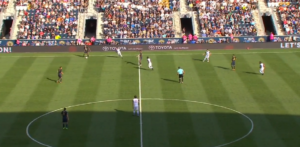
There are multiple players around the ball for the Union, but they are in each others’ lanes – bad positional play.
Deep breaths
But wait, just how bad was that loss on Sunday?
On first viewing, it was rancid. Any time it takes almost an hour to put a shot on target against a team that recently gave up 12 goals in three games, a period of intense self-assessment is in order.
The second time around, though, you notice that the problems were mostly self-inflicted, and that Philadelphia Union had every chance to control the match from start to finish. They just made a few bad decisions. Then a few more. Then a woeful mistake that led to a goal… and a few more bad decisions.
The lack of patience with the ball that has plagued the team over the past few months was their downfall. Repeatedly, Keegan Rosenberry chose to look long when a simpler option was available, or played the ball into the corner when treating Fabian Herbers as a dummy runner would have opened up the center of the pitch. Over and over, Fabinho looked to beat his man to the endline and pop a cross into the box regardless of whether numbers were there or not (and this after his intelligent cutback provided the Union’s first big chance in the first half).
And, connectedly, CJ Sapong and Chris Pontius drifted to the box to make runs as soon as the ball went wide to the fullbacks, regardless of where those fullbacks received the ball, and regardless of the way Orlando was set up defensively. In so many ways, the Union boxed themselves into low percentage opportunities. And, accordingly, they left the pitch without a goal.
[gfycat data_id=FantasticSlightBonobo data_autoplay=false data_controls=false data_title=true]
Two surprises
Looking back, the first surprise is how well Orlando defended in their 4-2-2-2 setup. The back line, never threatened over the top, held fairly high, and the deep midfield pairing aggressively attacked anything that came through the channels. Below, you can see how that aggression can be countered with cutbacks, with the keys being a) options must be available for the cutback (so everybody can’t go setting up for a cross the exact second Fabinho receives the ball), and b) Union players must also find good positions to close down any deflected ball that leads to a turnover.
[gfycat data_id=QuickClearcutCicada data_autoplay=false data_controls=false data_title=true]
Additionally, OCSC did a wonderful job trapping the Union on the touchlines — as many teams have done recently — and limiting Philly to a single passing option that was closed down with aplomb. Below you can see Brian Carroll survive through pure luck after he is setup and caught with the ball deep in his own end.
[gfycat data_id=IdolizedFarflungLangur data_autoplay=false data_controls=false data_title=true]
There are two big things to watch in that clip. First, look at how many men Orlando City has around the ball. The first man to press Carroll is Kaka, who has ninja’d all the way over from the left side to keep the Union locked in. The second thing to watch is Tranquillo Barnetta’s run on the ensuing break, which draws the defense narrow and opens a lane for Fabian Herbers. Barnetta never intended to get the ball, but he waves for it anyways to provide an additional distraction. Well done.
Alright, there is one more thing to watch on this clip: Just how unprepared the Union are for this pressure from the visitors. When a team is closing down a single corner of the pitch with no fewer than seven players, there are going to be outlets available. But where?
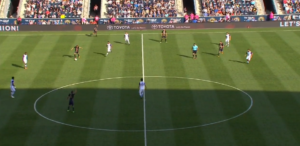
Orlando collapses to one side of the pitch, inviting the Union to find outlets.
In some cases, you can look for a horizontal outlet, but that can be dangerous deep in your own half because it means the fullback has to cheat out wide and will be far out of position if a turnover occurs. The second option is to perform something that could be called a ‘planned clearance,’ where the ball is played in the air to a target striker and the attacking midfielders anticipate a knockdown and line up in space for it. This is actually the tactic Orlando used against the Union quite often, with Ken Tribbett doing a wonderful job challenging Cyle Larin and limiting its effectiveness.
In the clip above, you can see that even if Brian Carroll had been able to play the ball long, Sapong, Barnetta, Pontius, and Herbers were already pushed so high that nobody would have been in position to collect a knockdown. That’s worrying given that Orlando created multiple midfield turnovers by pressing the Union’s holding midfielders.
The second surprise is how well, on second viewing, the Union defense played. Even with Tranquillo Barnetta often caught high, Philly really did do a fine job closing down the ball quickly and effectively. Unfortunately, so did Orlando City, which meant that turnovers were often quickly followed by long, aimless clearances or just balls popped into the air.
[gfycat data_id=CalmJointBovine data_autoplay=false data_controls=false data_title=true]
Above, you can see one example of the Union defense creating a transition opportunity. Alejandro Bedoya — who has toed the line between highly physical and worryingly foul-y for a few games now — wins the ball back in the Orlando City half. Sapong drives at the defense and plays the ball wide to Pontius, who should really be looking at a 1v5 in the box and looking to cut back and find more options. Instead, Pontius plays the ball inside, only to find Sapong sprawled on the turf after a laughably obvious foul on Aja.
I wonder if Ricardo Salazar could see that…
[gfycat data_id=WhimsicalRichEagle data_autoplay=false data_controls=false data_title=true]
Ilsinho’s strong play
After bouncing in and out of contention due to injury, Ilsinho returned with a burst of energy on Sunday. Almost instantly, he highlighted the differences between his game and that of Fabian Herbers.
Ilsinho likes to collect the ball in deep positions, preferably within 15-20 yards of the center circle. From there, he can draw a defense forward and look to play through or dribble through them. This varies in effectiveness, as the Brazilian is as prone to force vertical passes as he is prone to flummox a defender with an absurd move.
[gfycat data_id=ThatDeadlyAnteater data_autoplay=false data_controls=false data_title=true]
When teams back off into a defensive shell, Ilsinho really has a chance to shine. As Orlando City looked to protect its lead, pressure in the middle third receded, and Ilsinho could pick his spots inside and outside to link up with Rosenberry and scare the defense into a deep set that finally allowed the Union time to move the ball across the pitch if they so chose. All too often, they did not choose, which meant Orlando City was defending early crosses with 3-4 players (more on that later).
Ilsinho’s deeper play contrasts with Fabian Herbers vertical mentality. Herbers picks the ball up deep and looks to advance it, much like Tranquillo Barnetta does in the center. This can be positive, but it can also mean the Union end up attacking without numbers and locking themselves into one side of the pitch.
Further up the field, Herbers moves like a striker, making runs across the defense to drag players out of position. At times, this is extremely effective and allows the Union to find holes in front of a back line that is not evenly spaced. At other times, the Union treat Herbers’ decoy runs as viable passing options, which strands the ball in the corner and virtually necessitates a cross.
This is not good. The hope of Ilsinho is that he provides numbers through the center so Philly becomes far less reliant on the cross. Because generally, crosses are very low percentage opportunities.
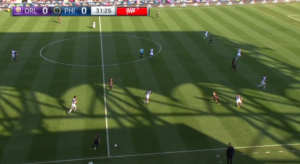
Rosenberry has an easy option in the center but chooses to look long instead.
Crossing numbers
Take a look at this play from Monday afternoon’s Manchester United-Liverpool match. OPTA coded that shot as a ‘big chance.’ After the match, pundits referred to it as a shot Ibrahimovic should have put away. Even Jurgen Klopp thought Ibrahimovic was likely to score there. After all, it’s an open header close to the goal.
So is a striker “likely” to score from such a position? The numbers say no. Crosses are generally very low percentage shots, and headed shots from anywhere except the area between the posts, free of pressure, are extra-low percentage shots. In short, this is not the type of shot a team should be looking to create. One expected goals model put Ibra’s chances of scoring at about 12.5%. Bad. No. Not good.
Numerous times in the second half, the Union played the ball wide to a player who was beyond the edge of the eighteen yard box. Attackers immediately drifted toward the center, queueing up for a cross. This emptied the options box for the man on the wing, who then sent in low percentage crosses to players who struggled to make anything of them. Remember, even the Union’s first shot on frame was a flying Sapong backwards-facing tap at goal from a low cross.
If a cross that connects with a target close to goal has a 12.5% chance of ending up in the net, what chance does any single cross have of ending up in goal? I don’t have that number, but I bet I can count to it on one hand.
The Union are a good team in the air, but aerial play should not be a first option. Too often, the team is willing to bypass short balls into the middle in order to pound the box with early crosses. This is the availability heuristic at work: One cross-to-goal stands out in memory and makes the tactic seem worthwhile.
Don’t be fooled: It’s not likely to lead to a goal.
Player ratings
Andre Blake – 4
Blake made the big save on Orlando City’s opener, and only an extremely lucky bounce off Rivas and spin on the turf led to the ball finding the net. Still, Blake’s distribution was below even his low-bar standards, including a few horrendous goal kicks and passes that put his team in trouble.
Keegan Rosenberry – 4
No major mistakes, but Rosenberry’s decision-making was lacking as he often went long when a simpler option was available.
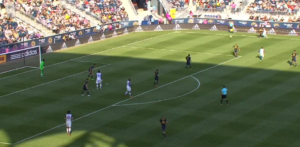
Tribbett is far too deep by himself here.
Ken Tribbett – 7
That was a fine performance by Tribbett. Aside from one early moment when he slipped covering Rivas and a few times when he dropped too deep, Tribbet dealt with Cyle Larin using a mixture of smart defending and tough physicality. Nothing special, but everything the Union needed.
Richie Marquez – 4
Gotta put your open headers on frame!
Fabinho – 2
I mean, he set up the big chance in the first half, and had very little support out wide (though his penchant for crossing makes that a bit of a self-fulfilling prophecy). But man, he really Steven Gerrard’d the Union. Furthermore, Fabi’s defense on the play below is so half-hearted it makes you scream. Sure, Barnetta could have shifted over to cover once the ball got free of the mess on the ground, but the lacksadaisical way Fabinho approaches the ball is troubling to say the least.
[gfycat data_id=InsistentThunderousIceblueredtopzebra data_autoplay=false data_controls=false data_title=true]
Brian Carroll – 6
A solid performance keeping everything on the wings.
Alejandro Bedoya – 4
Caught in possession twice and lucky not to have a goal hung around his head. Bedoya did a good job defensively, but still struggles to pick his moments going forward.
[gfycat data_id=EllipticalDrearyBaboon data_autoplay=false data_controls=false data_title=true]
Tranquillo Barnetta – 4
See Marquez.
Chris Pontius – 4
A strong start but he faded from relevance long before he should have against a fullback returning from an injury layoff.
Fabian Herbers – 3
Probably one of Herbers’ worst matches as a starter. It wasn’t so much that he did anything wrong positionally, but there were numerous instances where his touch let him down in key moments, with the big first half chance the most memorable.
CJ Sapong – 4
Finally getting shots on frame, but no good looks.
Substitutes
Ilsinho – 7
A much needed boost off the bench from the Brazilian, who can be so dangerous when teams sit back (and when he makes off the ball runs).
Roland Alberg – 5
He apparently played.
Charlie Davies – 5
It’s hard to get the rhythm of a match when you only get eight or so minutes to figure it out. Davies is proof of this many times over now.
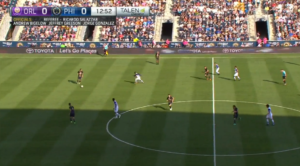
Ricardo Salazzzzzzzar
Geiger counter – 4
A fairly strong performance from Ricardo Salazar, though apparently not good enough to get his name spelled right on television. He missed a number of clear fouls on Sapong in the first half, but also had every right to send off Marquez for a clear cardable pullback and didn’t. So call it even.


I’m thinking that the Union’s difficulty in scoring lately is causing them to play more Route 1 football with the long passes rather than doing the things that had them at the top of the league in goals a month or two ago…and it’s turning into a vicious circle where not scoring is getting them to continue to just throw the ball forward which doesn’t lead to scoring…
Thanks for going to bat for Illsinho. I still think he is a good player who does things no one else on our team can do.
I agree. I just think Curtin has a tendency to misuse his talents.
Wow, a 4 for Salazar. No sarcasm, but I guess the game looks different from the press box, because from where I sat below the club he had an atrocious game. Not even anti-Union atrocious, or game-costing atrocious, just all-out bad. And even IF Marquez deserved to be sent off, that further justifies my point that he was terrible.
And after all of the 1st half stoppages, they only added one min of time to the half which was incredible.
I appreciate Illsinho, I just wish the players around him could anticipate his passes or his ideas so they could assist him. To many times he does something great, only to result in nothing because his teammates don’t know how to react or anticipate his next move.
This would come if he was healthier more as they would be use to his tendencies, but alas this is not the case.
James. James. James. I just smile in happy accompaniment.
.
Ilsinho brings chaos to the game by forcing a defense to lose shape then looks up to see his teammate more often than not…being spectators…
(1): I think you have to bench Sapong against NYRB. Start Herbers at CF and Ilsinho at RW. Sapong is just not performing and it is certainly not due to poor service or a lack of opportunities.
.
(2) A bit harsh on Rosenberry imo. How many times does he have to put a beautiful cross to the far post or across frame w/o anyone making the run? He hit crosses to the back post a number of times and Sapong either misread them or ran towards coverage. If we had an effective CF out there, Rosenberry would have had at least one assist. I think that’s why he gave up and moved to longer, more direct balls. Bedoya and Barnetta were not moving to get the ball from Rosenberry and when he put in a good cross, Sapong would botch the run.
@MikeR – Your (2) sort of speaks to my point. Hitting crosses requires a lot of moving parts to work together. I’ll agree there were times when the midfield didn’t support him, but I also noted numerous times that he passed up a centering pass to go long. Even with his accuracy, and even if a very good header is in the game, crossing is not a good way to score.
–
CJ did have a pretty great year with his head in 2012 though. 20 headed shots, 9 on target, 4 goals. That put him in elite company, but only 5 players have ever had anything like that kind of season with their head more than once in MLS.
–
http://www.americansocceranalysis.com/home/2016/10/18/is-finishing-real-heading-towards-a-conclusion
You’re right. I’m just having trouble living in a reality where Rosenberry is anything but a phenom.
.
I think the point about how chemistry plays into the success of crosses is particularly relevant. That’s been a big component of Sapong’s drought imo. Just seems to be in a different mindset than his teammates.
Sapong is just slow to read the game as I have posted before. It is his reason for being late to poach goals, it is his reason for anticipating crosses to late, and it is the reason he doesn’t make runs. He just doesn’t see the game well or have the soccer IQ. Think throughout the season as Pontius and Herbers movement for examples. Both not only make the runs but vary what they are doing and click better with timing. Yes Herbers has been no scoring phenom, but his movement has caused more opportunities then I have seen from Sapong over the season.
RE: Bedoya. I remember one moment early in the game when the Union where building out of the back, with Tribbet on the ball on the right side of the field.
Bedoya was wide open next to him in the center of the field.
Tribbett waited, waited, stalled, hesitated, then turned and passed it back to Blake.
This is a Carroll problem and was evident when Nogs was here too. We require our 8 to drop between the center backs to build play out of the back because our 6 cannot do it. But that forces our 6 up to the 8 position and Carroll cannot play that either so he stands around. It causes us to attempt to build up play out of the back effectively down 1 player and negates our midfield numbers advantage.
.
This is further strained when we have our 4 most forward players take up off field when we have the ball causing us to have 5 players in the back and 4 players in the front with no one dropping or stepping to connect these 2 lines (note: Carroll is wandering aimlessly on offensive in this setup)
Boom You nailed that’s exactly what’s wrong with this team !
Disagree that our system is designed for the 8 to play it out of the back because Carroll cannot. Carroll has dropped between the centerback many times this season and played the ball out of the back. While he won’t dazzle with a pass that takes out 3-4 defenders, he does an effective job of moving ball. Bedoya should be further up to link the attack like Noguiera did and make sure that he doesn’t get caught in possession like he did on Sun. Many of the Union’s problems are because they are predictable in how they play and when teams press to take away those options, they make mistakes and turn the ball over.
Its funny you mentioned the pogba cross to Ibra- I thought for sure it was going to be a goal. Reminded me of Ronaldo serving up Varela to break our hearts in 2014. Except Ibra missed :/
Good to see Tribbett get some love too considering the flack he got for poor play (including from me). He was the best Union player on the field for me and did well to keep Larin quiet.
+1
The Union are a good team in the air, but aerial play should not be a first option. Too often, the team is willing to bypass short balls into the middle in order to pound the box with early crosses. This is the availability heuristic at work: One cross-to-goal stands out in memory and makes the tactic seem worthwhile.
Don’t be fooled: It’s not likely to lead to a goal.
.
.
.
.
It mean a lot to me as a poster here that you have highlighted this because it is important and a big big big issue…in my opinion.
.
Shows an inability to solve the defense. Shows an inability to move off the ball. Shows an inability to be creative. There are crosses and there are crosses and crosses and crosses.
Which is why Herbers should start up top and Ilsinho at right mid.
And Curtin should tell Ilsinho the first time he drops his man on D he gets a warning and the next time he’s subbed.
Its really a shame – Ilsinho had his position taken by a (admittedly really good) rookie because he cant defend his opposite midfielder. To think about what could have been if he could just play some D…